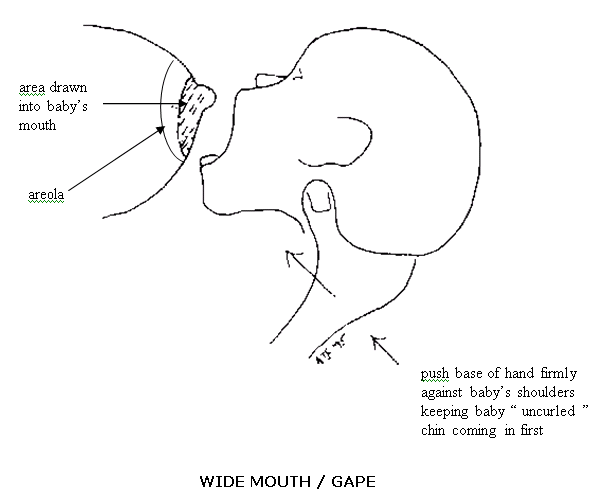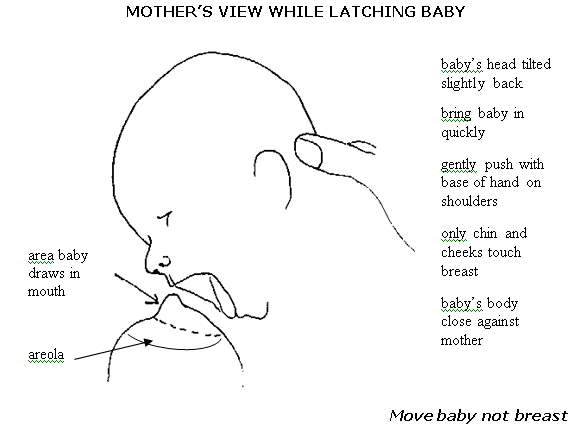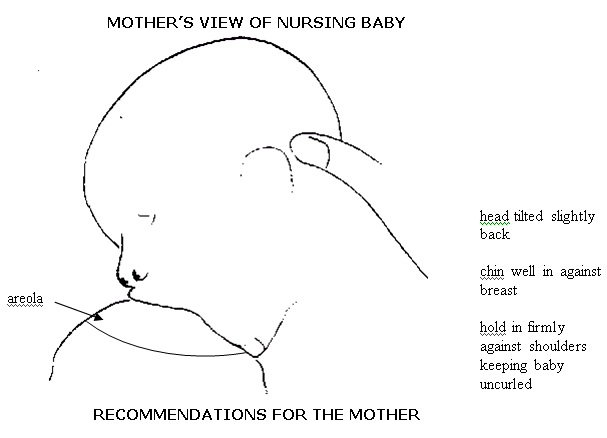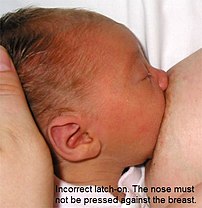- in Breastfeeding by Alexis Rodrigo
- |
- 1 comments
Breastfeeding Tips: Latching On
The Proper Way to Latch Baby on for Breastfeeding
by Dr. Jack Newman
Cross Cradle Position for Left Breast:
• Align baby’s nose so that it does not go past your nipple, or go to the left of your nipple, in other words, your nipple should not be aligned with his chin
• Place your right hand under baby’s face so your four fingers make a pillow for baby’s cheek (keep your four fingers tightly together as if the were stuck together with glue)
• You are now supporting the weight of baby’s head with your hand
• You may want to sit baby’s bottom on you arm as though it were a shelf (this will work in the beginning with a newborn)
• Or you may want to let baby’s bottom fall diagonally a bit and squeeze it against your rib cage with your elbow
[ad#ad-2]
• Baby’s body and legs should be wrapped in around mother.
• Pull baby’s bottom into your body with the inside/underside of your forearm as if serving baby to you on a platter
• This will bring him toward your breast with the nipple pointing to the roof of his mouth
• Head supported but NOT pushed in against your breast.
• In fact, try to think of it not as bringing baby’s head into or near your breast at all—instead, bring baby’s body into your body and the head will follow.
• Head should be tilted back slightly s the nose is up and the baby’s chin is coming into the breast while the nose never touches the breast.
• Use your whole arm to bring the baby onto the breast, when mouth wide.
• Baby’s chin should be far away from Baby’s chest.
WATCH LOWER LIP, aim it as far from base of nipple as possible, so tongue draws lots of breast into mouth. Move baby’s body and head together – keep baby uncurled. If you keep your wrist straight, with baby’s cheek resting on your fingers, then baby’s chin will not bend down toward his chest. Once latched, baby’s top lip will be close to nipple, areola shows above lip. Keep baby’s chin close against your breast.

Need mouth wide before baby moved onto breast. Teach baby to open wide/gape:
• Avoid placing baby down in a feeding position until you are completely ready to latch baby. The longer baby waits while you get ready (undoing your breast, etc) the more frustrated baby gets and the less open baby’s mouth will go.
• move baby toward breast, touch top lip against nipple
• move mouth away SLIGHTLY
• touch top lip against nipple again, move away again
• repeat until baby opens wide and has tongue forward
• Or, better yet, run nipple along the baby’s upper lip, from one corner to the other, lightly, until baby opens wide


Mother’s Posture
• Sit with straight, well-supported back
• Trunk facing forwards, lap flat
Baby’s Position Before Feed Begins
• Nipple points to the baby’s upper lip or nostril
Baby’s Body
• Placed not quite tummy to tummy, but so that baby comes up to breast from below and baby’s eyes make
contact with mother’s
Support Breast
• Firm inner breast tissue by raising breast slightly with fingers placed flat on chest wall and thumb pointing up (if helpful, also use sling or tensor bandage around breast)
Move Baby Quickly On To Breast
• Head tilted back slightly, pushing in across shoulders so chin and lower jaw make contact (not nose) while mouth still wide open, keep baby uncurled (means tongue nearer breast) lower lip is aimed as far from nipple as possible so baby’s tongue draws in maximum amount of breast tissue
Cautions
Mother needs to AVOID
• pushing her breast across her body
• chasing the baby with her breast
• flapping the breast up and down
• holding breast with scissor grip
• not supporting breast
• twisting her body towards the baby instead of slightly away
• aiming nipple to centre of baby’s mouth
• pulling baby’s chin down to open mouth
• flexing baby’s head when bringing to breast
• moving breast into baby’s mouth instead of bringing baby to breast
• moving baby onto breast without a proper gape
• not moving baby onto breast quickly enough at height of gape
• having baby’s nose touch breast and not the chin
• holding breast away from baby’s nose (not necessary if the baby is well latched on, as the nose will be away from the breast anyway)
See videos of latching and latching in other positions at www.drjacknewman.com
Questions? Email Jack Newman at drjacknewman@sympatico.ca, or Edith Kernerman at breastfeeding@sympatico.ca or consult: Dr. Jack Newman’s Guide to Breastfeeding (called The Ultimate Breastfeeding Book of Answers in the USA) or our DVD, Dr. Jack Newman’s Visual Guide to Breastfeeding; or The Latch Book and Other Keys to Breastfeeding Success; or L-eat Latch & Transfer Tool, or the GamePlan for Protecting and Supporting Breastfeeding in the First 24 Hours of Life and Beyond. See our website at www.drjacknewman.com. To make an appointment email breastfeeding@ccnm.edu and respond to the auto reply or call 416-498-0002.
Handout, When Latching ©May 2008
Revised by Jack Newman, MD 2005, 2008, and Edith Kernerman, IBCLC 2008
Original written and designed by Anne Barnes
This handout may be copied and distributed without further permission, on the condition that it is not used in any context that violates the International WHO Code on The Marketing of Breastmilk Substitutes
[!AdServe:Motherwear!]If you liked this post, submit your email address below to get new posts by email:


![Reblog this post [with Zemanta]](https://img.zemanta.com/reblog_e.png?x-id=8df5eb48-b107-4c55-bcc9-15e22dd018f5)